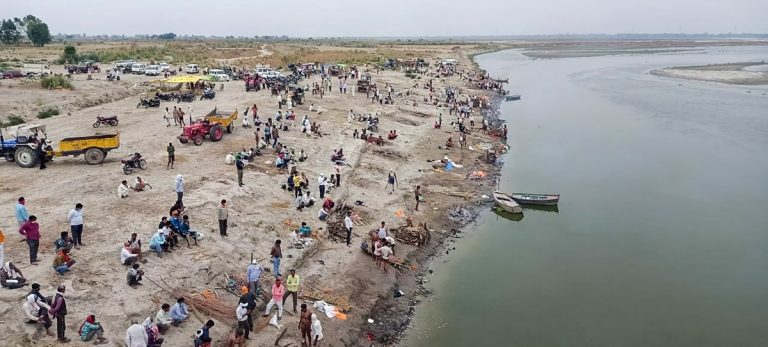
Some 30 photojournalists walked the banks of Ganga and counted 2,000 bodies on May 12 and 13 alone, while the state authorities have claimed that just 7,826 people died from Covid-19 between April 1 and May 13.
By Nazarul Islam
Devoted Hindus in India have believed that immersing their bodies in the holy river Ganges shall purify their soul. When the second wave of the coronavirus pandemic hit Indians with catastrophic intensity, the holy river became a harrowing symbol of the Modi administration’s failures and deceptions.
Of late, the northern state of Bihar revised its death toll for April and May from 5,424 to 9,375. Private agencies which were tasked with conducting Covid-19 tests at Kumbh Mela, had reported ‘falsified’ (concealed) about 100,000 cases of tragic demises, as a result of the debilitating pandemic. Every year the Kumbh Mela, a (Hindu) religious festival in northern India attracts millions of pilgrims. In the peak of the religious festival, this April, the super-religious event transformed into a super spreading opportunity of COVID-19, claiming a vast number of casualties.
Finally…the second wave of infections now appears to have ebbed, but the country is struggling to process the staggering toll — with nearly 3,80,000 dead, the vast majority since just March — hobbled by the continuing obfuscation of both local and central authorities. However, the holy Ganga has not lied—rather exposed the realities, to people of the country.
On May 12 of this year, villagers in Buxar, a district in Bihar, had found bloated and disfigured corpses floating in the river. Some 100 bodies were fished out there and in another district upstream, Ghazipur. A local senior police officer said the bodies had travelled downriver, from Uttar Pradesh.
To get a clearer sense of the devastation caused by the pandemic among the masses, the local newspaper sent 30 photojournalists who simply walked the banks of the Ganga, on locations near major cities and districts in the state of Uttar Pradesh.
The journalists had counted 2,000 bodies on May 12 and 13 alone, as they travelled a length of nearly 700 miles along the river. The bodies weren’t only floating —at some locations, 65 or 70 had washed up on the shores. According to the most reliable, on the spot estimates based on assimilated data, the state authorities have claimed that just 7,826 people died from Covid-19 between April 1 and May 13.
Shringverpur, a small village in southern Uttar Pradesh, is considered a holy place for its association with Lord Rama. News reporters had observed many bodies buried on the shores of Ganges, just a yard apart; hundreds of saffron shrouds wrapped around the corpses were poking up from the ground. Poor villagers who couldn’t afford to buy wood to cremate their kin had sought some solace by burying them near a sacred site.
After careful computation, based on reports filed by newsmen, it has been estimated that between mid-April and mid-May some 4,000 corpses had been placed in shallow pits by the river along a stretch of less than one mile.
We might never have heard of this tragedy but for the weather. Rains in early May swelled the Ganga, tossing up corpses to the river’s surface and onto its shores. They washed off the dirt from the banks, exposing the bodies buried there.
The heavy seasonal rains also laid bare the government’s colossal failure to strengthen rural health care or ensure adequate vaccine supplies — or take responsibility for its shortcomings.
Uttar Pradesh has been governed by the BJP of Prime Minister Narendra Modi since March 2017, under Chief Minister Yogi Adityanath, a Hindu monk-turned politician. Adityanath’s response in April to grave shortages of oxygen, ventilators and beds in intensive-care units throughout the state, and to the images of overcrowded cemeteries and crematories, was denials and threats. He directed state officials to invoke anti-terrorism laws against, and seize property from, people he accused of spreading rumours.
Also read:
Gujarati Writers, Readers Condemn Vilification of Poem on Ganga Corpses
The Uttar Pradesh government has only maintained records of deaths arising in hospitals. Yet many people from villages, where access to health care is limited, had been lost their lives at home.
In mid-May, a doctor in Reotipur, a village of about 70,000 in Ghazipur district — the only doctor there — told one of the volunteer reporters that about 850 people had tested positive for the coronavirus. Some villagers told him that around 200 people there had died in April.
“We are poor people,” Mahendranath Upadhyay, a villager who lost three members of his family to Covid-19, told a reporter. “We barely manage to earn enough to eat. We don’t have the money for medical treatment.”
Rural poverty has exacerbated the effects of the second wave of infections, but it was the Modi government’s callous disregard that triggered the latest surge. The authorities allowed the Kumbh Mela pilgrimage, one of the world’s largest religious gatherings, in the spring, as well as elections in several states, including Uttar Pradesh.
When Modi was campaigning to become prime minister in 2014, he ran for a parliamentary seat from Varanasi, a holy city on the Ganges in Uttar Pradesh. He had said then, “I feel Mother Ganga has called me to Varanasi.” Times have changed. It is Ganga’s turn to call out Modiiiii…
[author title=”Nazarul Islam ” image=”https://sindhcourier.com/wp-content/uploads/2021/05/Nazarul-Islam-2.png”]The Bengal-born writer Nazarul Islam is a senior educationist based in USA. He writes for Sindh Courier and the newspapers of Bangladesh, India and America. He is author of a recently published book ‘Chasing Hope’ – a compilation of his 119 articles.[/author]